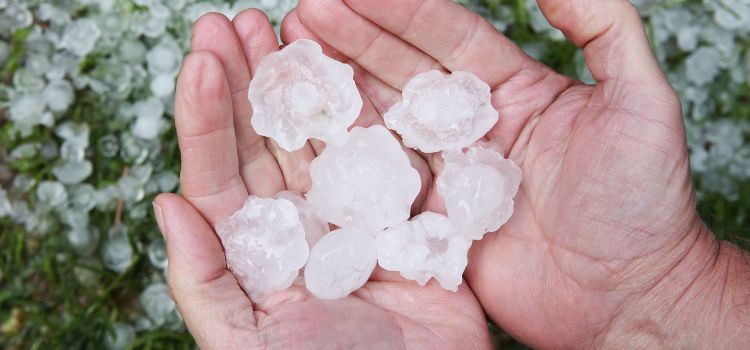If you’ve wondered, “Can hurricanes produce hail?” you’ve come to the right place. This article explores how hail is created and why it’s different from snow. You’ll also learn the science behind hail.
Contents
After reading this article, you’ll know how to identify hail and protect yourself from it. Hail can fall from the sky like snow and fall like small rocks or as large as golf balls.
Do hurricanes create hail?
Hurricanes can produce hail, but not all storms do. Hail formation requires a powerful updraft. However, in hurricanes, the updraft is very diffuse and does not approach supercell intensity.
It is, therefore, difficult for the storm to produce hail. This article will explore the mechanism by which hurricanes create hail. It will also explain the reasons for the large number of hailstones made during a hurricane.
The primary mechanism for producing hail requires strong thunderstorm updrafts that prevent growing ice particles from falling. Hailstones are tiny ice crystals that have been lifted high by the central updraft of a thunderstorm.
These particles are then swept up in a cloud called a cumulonimbus. Cumulonimbus clouds are composed of supercooled water drops and ice crystals. These two conditions work together to create hail.
Another mechanism behind hail creation in hurricanes is high-altitude air. This high-altitude air is cold enough that liquid water will have frozen into ice. But the moisture in the air is not enough to form hailstones.
It needs liquid water to grow. Hence, hail formation in the upper level of a storm is related to its evolution. Nevertheless, it is essential to understand that the VIL density depends on atmospheric conditions.
You can find out more info here on how a hurricane affects the biosphere, hydrosphere, lithosphere and atmosphere.
While the northern hemisphere has the highest hailstorm frequency, most hail falls in the southwestern part of the U.S. The heaviest hailstorms are found in Colorado, Wyoming, and the Dakotas. They are located just south of the Rocky Mountains. If hail is expected in your region, you’ll likely experience it in one of these states.
What is hail?
Hail is a form of solid precipitation. It is distinct from ice pellets because it is composed of individual lumps or balls of ice. These lumps are called hailstones. In cold weather, the air temperature is too cold for them to grow.
However, during warm weather, the air temperature is too warm for them to grow. Therefore, hail is a form of severe weather, so it is essential to know how to prevent it.
The definition of hail is quite complex. It is an icy pellet of ice, usually between five and fifteen centimeters in diameter. Hail is incredibly destructive and is often a significant cause of property damage.
In fact, hail can damage plants, buildings, and even machinery. This is why hail is so dangerous. If it is large enough, it can destroy entire crops and infrastructure. For this reason, it is vital to understand how hail is created.
Hail is created when supercooled water droplets accumulate in an upward-streaming Cumulonimbus cloud. Hail grows by freezing and melting as it moves through the warm and cold air. Hailstorms can occur at any time of the year.
However, summer hail is different from winter hail, which precipitates as dust hail. However, there is no definitive rule that hail is dangerous. The key is to stay safe and protected!
The basic process for hail formation is simple. Water vapor evaporating from the surface of the earth condenses in the air. This moisture forms tiny pieces of ice called nuclei. As these droplets accumulate in the atmosphere, they accumulate and grow until their weight exceeds the strength of an updraft.
These particles then fall to the ground. Hailstones come in many shapes and sizes. A piece of hailstone can have many layers, just like a tree ring.
How is hail created?
Whether in the Midwest or the southern tip of Florida, you’ve probably seen photos of the devastating damage caused by hailstorms. Hailing is composed of small chunks of ice that form in fast-moving thunderstorms.
Hail is dangerous, and it can ruin crops, aircraft, and homes. In 2010, the U.S. saw an average of seven to nine days of hail in some areas, according to the National Severe Storms Laboratory (NSSL).
The formation of hail is a result of a powerful updraft. This strong updraft allows the large hailstones to form loops inside the thunderstorm cloud, which increases in diameter. As ice accumulates within the hailstone, it grows in size.
This process is referred to as “wet growth.” This growth process is favored over dry growth because the ice outer shell is liquid. The stone then accretes smaller, supercooled raindrops and eventually more giant hailstones.
Strong updrafts in thunderstorms create the conditions for hail to form. This motion prevents the growing ice particles from falling to the ground. This is the main reason why hailstones look layered.
Hailstones start as tiny ice crystals, and the supercooled water droplets then spread across them. During this process, the ice crystals grow in layers. These layers form a layer of clear ice.
The energy required to create hail comes from the high-speed winds accompanying thunderstorms. This updraft can last for several minutes or even hours. However, it’s important to note that this energy transfer is limited by physical limits. Consequently, hailstorms are not as powerful as supercell thunderstorms. However, the intensity of these storms is sufficient to produce hail. The process also requires a strong updraft.
Hail vs. snow
While the weather is not the same in every region, there are a few similarities between the two. The latter is often accompanied by intense winds, while hailing forms in thunderstorms with high liquid water content and a wide vertical extent.
Its growth rate peaks at -13 degrees Celsius and shrinks to zero at -30 degrees Celsius. In extreme cases, small hail can form a vast pile several feet deep, mimicking the effect of ice on roads in winter.
Two main types of precipitation occur in hurricanes – snow and hail. While the snow falls during the winter, hail can cause damage by accumulating on trees, power lines, and other structures.
Although hail stones fall during thunderstorms, freezing rain does not occur during hurricanes. Unlike snow, hail is typically a chunk of ice falling from the sky like a small, icy chunk.
The primary difference between hail and snow is the size of the precipitation. Hail is composed of small ice balls, whereas snow is made of delicate, crystalline flakes. They measure between five and fifty millimeters in diameter and are formed by severe thunderstorms.
Cumulonimbus is the storm structure that produces hail. Hailstones are made of multiple layers of transparent or translucent ice, each at least one mm thick. A small hailstone can be irregular in shape.
While snow and hail are both common forms of precipitation, each one is a different kind. While snow may be the most common, hail is more likely to form when air moves upward. Unlike snow, hail tends to last longer.
Related – can a hurricane have snow?
Eventually, air cannot hold the hailstone, and it falls to the ground as hail. If the hail is big enough, it will be heavy. The hail will fall as snow if there isn’t enough air to hold it up.

